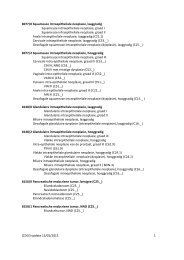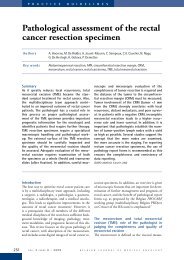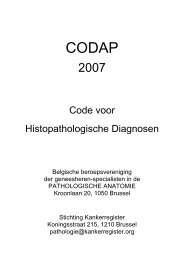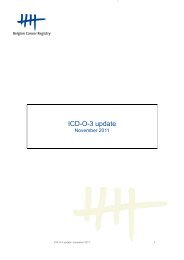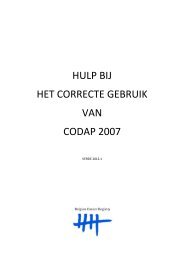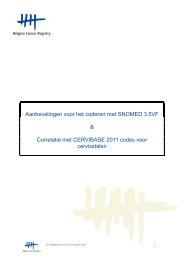Assurance de qualité pour le cancer rectal – phase 2 ...
Assurance de qualité pour le cancer rectal – phase 2 ...
Assurance de qualité pour le cancer rectal – phase 2 ...
You also want an ePaper? Increase the reach of your titles
YUMPU automatically turns print PDFs into web optimized ePapers that Google loves.
80 PROCARE <strong>–</strong> <strong>phase</strong> 2 KCE reports 815 CONCLUSIONSThe ultimate aim of PROCARE is to <strong>de</strong>crease diagnostic and therapeutic variabilitybetween centres and to improve the quality of care for all patients presenting with<strong>rectal</strong> <strong>cancer</strong>. The i<strong>de</strong>ntification of teams with suboptimal performance is a <strong>de</strong>licatematter and requires well-<strong>de</strong>veloped quality indicators, high-quality data (with a<strong>de</strong>quateapplication of <strong>de</strong>finitions), and adjustment for risk factors. The combination of aliterature search and expert opinion ma<strong>de</strong> it possib<strong>le</strong> to construct a set of 40 re<strong>le</strong>vantQI for <strong>rectal</strong> <strong>cancer</strong>. For most se<strong>le</strong>cted QI, all necessary e<strong>le</strong>ments to be measurab<strong>le</strong> areavailab<strong>le</strong> in the PROCARE database and/or administrative databases. However, based onthe results of the present study, a refinement of some QI and of the PROCARE dataentry form is necessary. Also, in or<strong>de</strong>r to minimise the number of missing data and toincrease the performance of the PROCARE data registration and analysis, a webapplication for data submission should be <strong>de</strong>veloped. Training of datamanagers isessential for an efficient and correct col<strong>le</strong>ction of patient data.The present study shows that a linkage between the BCR database and otheradministrative databases is feasib<strong>le</strong> and highly accurate (at <strong>le</strong>ast for the linkage betweenthe BCR and HIC databases). The BCR data were shown to be exploitab<strong>le</strong> and re<strong>le</strong>vantfor at <strong>le</strong>ast part of the se<strong>le</strong>cted quality indicators. Apart from the administrative BCRdata, the BCR has also proved to have the necessary capacity for prospective dataregistration and analysis. Therefore, the BCR is an essential partner for future similarprojects.Using the administrative databases, some re<strong>le</strong>vant QI were measurab<strong>le</strong>. However, thetotal number of measurab<strong>le</strong> QI was rather low. Of these, the outcome indicators onsurvival and mortality, measurab<strong>le</strong> with data coming from the Sickness Funds, canprobably be consi<strong>de</strong>red the most meaningful. For this project, the contribution of theMCD-MFD database was limited.The PROCARE project is a pilot project for Belgium. So far, many centres involved inthe PROCARE project only inclu<strong>de</strong>d a low number of patients, making an interpretationof most QI difficult at present. Neverthe<strong>le</strong>ss, the involved centres expect a firstindividual feedback very soon. Therefore, it should be consi<strong>de</strong>red to give this feedbackwithout further interpretation until the end of 2009. By then, the total amount ofinclu<strong>de</strong>d patients can be expected to exceed 2500. At that time, the re<strong>le</strong>vance andinterpretability of the QI should be reassessed, e.g. by comparing the PROCARE data tothe administrative data for the same time period and by performing risk-adjustmentwhere necessary. At a later stage, it can also be consi<strong>de</strong>red to pool the results of thesmal<strong>le</strong>r centres (i.e. with 5 or <strong>le</strong>ss patients per year), and to provi<strong>de</strong> these poo<strong>le</strong>dresults in addition to the individual feedback.In view of the nee<strong>de</strong>d refinements and difficult interpretation of the QI at present, itshould be stressed again that the preliminary QI results presented in this report cannotbe used to judge the quality of <strong>rectal</strong> <strong>cancer</strong> care. In<strong>de</strong>ed, given the relatively lownumber of inclu<strong>de</strong>d patients per PROCARE centre, this study seems to be done toosoon to draw firm conclusions. I<strong>de</strong>ally, this exercise was piloted with a much morefrequent <strong>cancer</strong>, such as breast <strong>cancer</strong>.The prospective PROCARE registration is on a voluntary basis, and to increase theownership of the project, this voluntarism should be encouraged. Registration bur<strong>de</strong>n isan important threat for this project, and it is therefore recommen<strong>de</strong>d to revise thecurrent data entry form, which is very exhaustive at present. By providing the individualfeedback in an attractive, professional and comprehensib<strong>le</strong> lay-out, additional centrescan be convinced to join the project.In the long run, the coverage of the PROCARE registration needs to be improved andassured, e.g. by providing incentives or by checking the coverage through linkage withadministrative databases. In<strong>de</strong>ed, as comp<strong>le</strong>te as possib<strong>le</strong> coverage is essential to allow ameaningful population-based international benchmarking. The present study has shownthe potential for such an international exercise. However, it is recommen<strong>de</strong>d to await ahigher amount of inclu<strong>de</strong>d patients.



